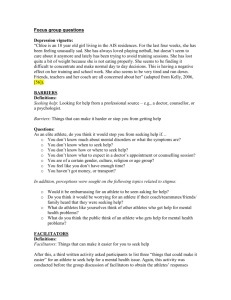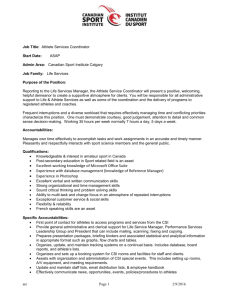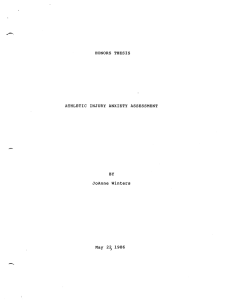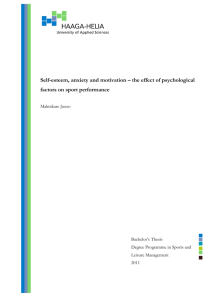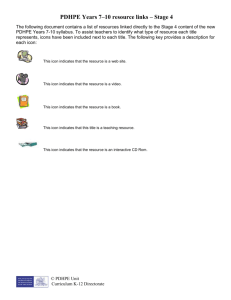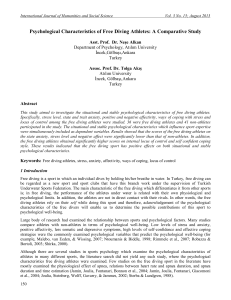a printer friendly version of this teaching activity
advertisement
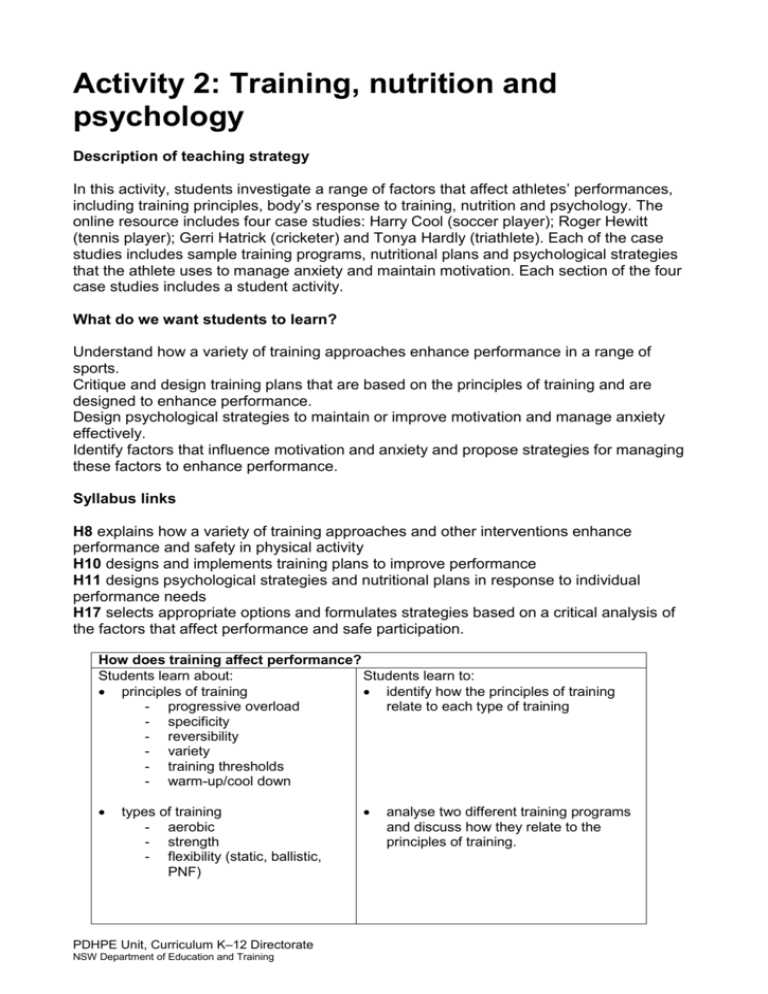
Activity 2: Training, nutrition and psychology Description of teaching strategy In this activity, students investigate a range of factors that affect athletes’ performances, including training principles, body’s response to training, nutrition and psychology. The online resource includes four case studies: Harry Cool (soccer player); Roger Hewitt (tennis player); Gerri Hatrick (cricketer) and Tonya Hardly (triathlete). Each of the case studies includes sample training programs, nutritional plans and psychological strategies that the athlete uses to manage anxiety and maintain motivation. Each section of the four case studies includes a student activity. What do we want students to learn? Understand how a variety of training approaches enhance performance in a range of sports. Critique and design training plans that are based on the principles of training and are designed to enhance performance. Design psychological strategies to maintain or improve motivation and manage anxiety effectively. Identify factors that influence motivation and anxiety and propose strategies for managing these factors to enhance performance. Syllabus links H8 explains how a variety of training approaches and other interventions enhance performance and safety in physical activity H10 designs and implements training plans to improve performance H11 designs psychological strategies and nutritional plans in response to individual performance needs H17 selects appropriate options and formulates strategies based on a critical analysis of the factors that affect performance and safe participation. How does training affect performance? Students learn about: Students learn to: principles of training identify how the principles of training - progressive overload relate to each type of training - specificity - reversibility - variety - training thresholds - warm-up/cool down types of training - aerobic - strength - flexibility (static, ballistic, PNF) PDHPE Unit, Curriculum K–12 Directorate NSW Department of Education and Training analyse two different training programs and discuss how they relate to the principles of training. How can psychology affect performance? Students learn about: Students learn to: motivation research case studies of a number of athletes to ascertain the nature of their positive and negative motivation and the psychological intrinsic and extrinsic strategies they employ social, material and internal reinforcement anxiety trait and state anxiety sources of stress optimum arousal managing anxiety concentration/attention skills (focusing) mental rehearsal visualisation relaxation goal-setting discern the difference between anxiety and arousal in terms of the effect on performance apply a range of psychological strategies to practical laboratories How does nutrition affect performance? Students learn about: Students learn to: balanced diet design a pre-event and recovery nutritional plan for an athlete that is it adequate for performance includes the principles of carbohydrate needs? loading supplementation vitamins compare the pre-performance diets of minerals several athletes, considering: carbohydrate loading use of diet supplements fluid intake levels hydration foods consumed principles of body temperature regulation Activity Access to computers is necessary for this activity. Up to four students can work on a single computer. 1. Divide students into small groups up to four. 2. Allocate each group to one of the four case studies. 3. Each group works through the training program section for their allocated case study completing each of the student activities. 4. Groups report back to whole class on their findings in relation to training plans. 5. Two groups now join together and compare training plans to analyse differences and determine how the principles of training relate to each plan. 6. In original groups, students now work through the body’s response section of their allocated case study, completing the student activity. 7. Share findings with a different group and compare findings across the two sports. 8. Students, as individuals or in groups, work through the student activities in the nutrition and psychology sections of each case study. PDHPE Unit, Curriculum K–12 Directorate NSW Department of Education and Training 9. Students select one of the athletes and design a pre-event and recovery diet plan. Present these to the class and discuss similarities and differences between the four athletes. 10. Students identify one of the athletes and propose strategies that the athlete could use to manage anxiety, arousal and motivational levels. PDHPE Unit, Curriculum K–12 Directorate NSW Department of Education and Training Checking for learning - How have each of the principles of training been applied to the training plans for the four athletes? - What are the major similarities and differences between each of the four training programs? - What are the immediate responses to exercise that the body undergoes? - How do the immediate responses differ for each of the four athletes? - What long term physical adaptations would you expect each of the four athletes to experience as a result of implementing their training plans? - What is the nature of each athlete’s motivation? - How can each athlete’s arousal levels be managed in order to prevent over-arousal leading to poor performance? - What are the major considerations that need to be taken into account when designing pre-event and recovery diets for each of the four athletes? PDHPE Unit, Curriculum K–12 Directorate NSW Department of Education and Training


